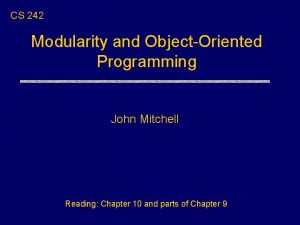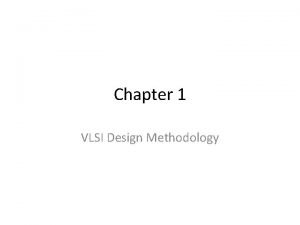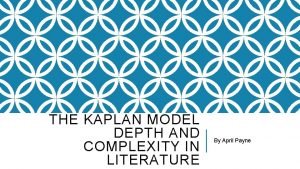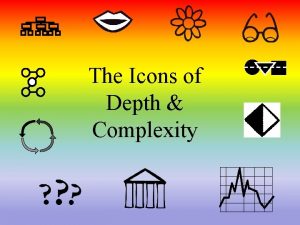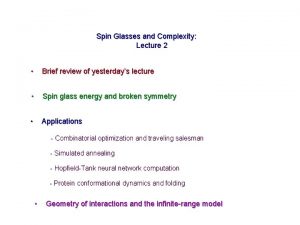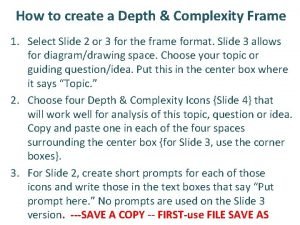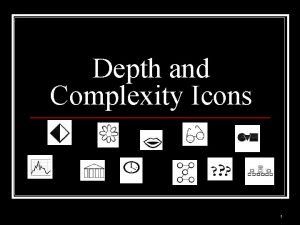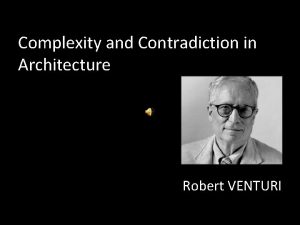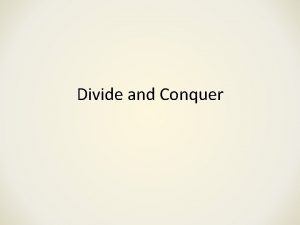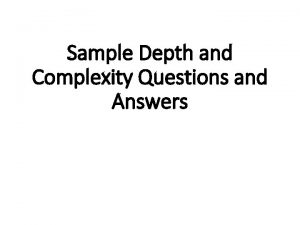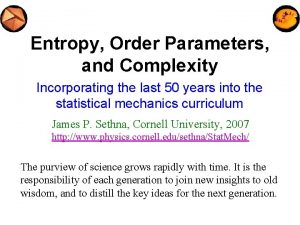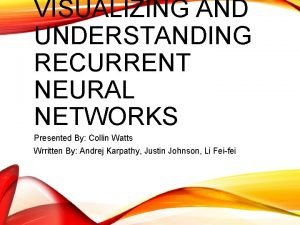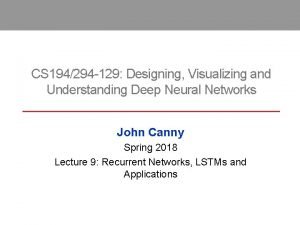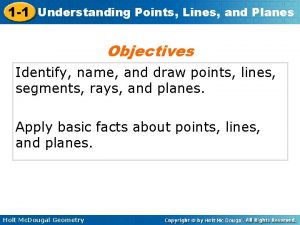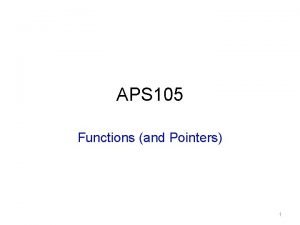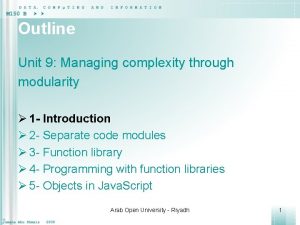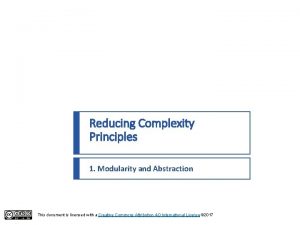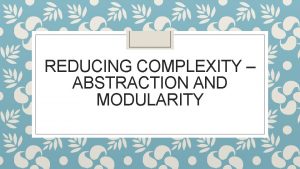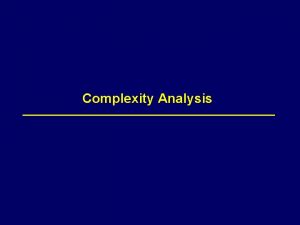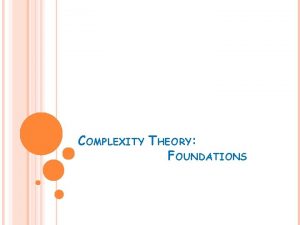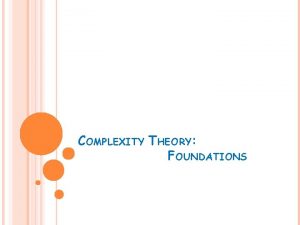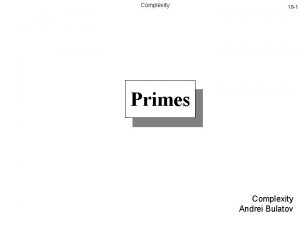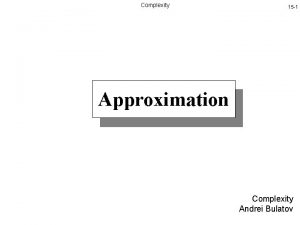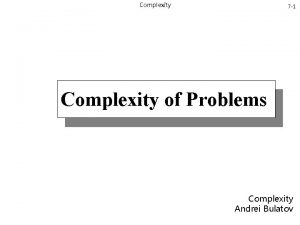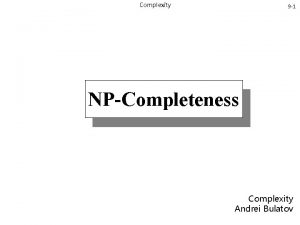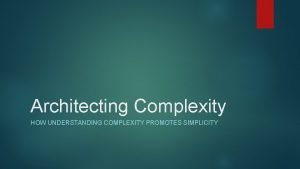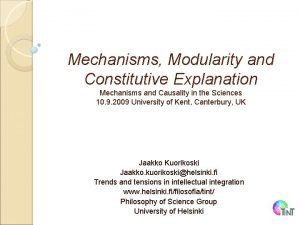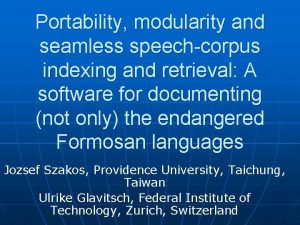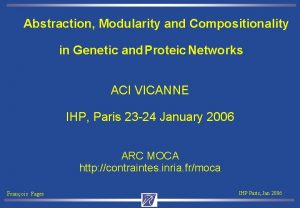Complexity and Modularity Outline o Complexity n Understanding




































- Slides: 36

Complexity and Modularity

Outline o Complexity n Understanding complexity n Granularity and context o Modularity n Architecture and modules n Importing and exporting n Coupling and cohesion n Design elements and design rules n Task structure matrix n Modular operators o Summary

Complexity o Complexity in designs can be measured by the interconnectedness of things. o Complexity is a function of the degree of dependency among elements of a system. o A directed graph is a convenient way to show these dependencies as long as the number of nodes doesn’t exceed our ability to view and analyze the diagram.

The Design Structure Matrix (DSM) o An alternative to a directed graph is a DSM. o It is an N by N matrix where the same elements appear as rows and columns in the same order. (The diagonal is ignored. ) o An X is placed in the matrix where a dependency exists. The element corresponding to a given row is dependent upon the elements in the columns for which an X appears

The Design Structure Matrix (DSM) Example Element A Element B 0 Element B X 0

Complexity Arises in Many Aspects of Software Design o Requirements o User Interface o “High-level” design o “Low-level” design o Source code

Understanding Complexity o The complexity of a software design is associated with the length of its description. o The greater the number of dependencies the longer the description. o Using abstraction more elements can be added while reducing the ratio of dependencies to elements (although the actual number of dependencies may go up. )

Understanding Complexity (Cont’d) o As the complexity of the architecture increases, the complexity of the individual models can decrease. o Hierarchically decomposing a system allows us to distribute complexity across multiple components. o We can reduce the apparent complexity of a system by our choice of design language.

Granularity and Context q “When defining complexity it is always necessary to specify a level of detail up to which the system is described with finer details being ignored. Physicists call that ‘course graining. ’” (Murray Gell. Mann) q You cannot understand the architecture of a system by looking at low-level design models and source code.

Granularity and Context (Cont’d) o Complexity depends not only on the number of dependencies, but also on the pattern of dependencies. o One must also take into account the relationship types. o Part of managing complexity is in our ability to improve the comprehensibility of a system. Although this doesn’t reduce complexity, it improves our ability to understand reason about the system.

Varying Degrees of Complexity – Fully Connected DSM A B C D E A O X X B X O X X X C X X O X X D X X X O X E X X O

Varying Degrees of Complexity – Fully Disconnected DSM A A B C D E O O O

Varying Degrees of Complexity – A Layered Architecture A B C D A O B X O C X X O D X X X O E X X E O

Varying Degrees of Complexity – Also a Layered Architecture A B A O X B X O X X O C D E

Varying Degrees of Complexity – The Most Complex A A B C O X X O D E O B C X D X E X O X X O

Modularity o Modularity is the primary principle by which we manage complexity of designs and design tasks by identifying and isolating those connections or relationships that are the most complex. o The principles of coupling and cohesion are important to understand how to create a modular architecture. o Modular operators can help to achieve a simpler design.

Architecture and Modules o We distinguish between a static design- level view of the system’s structure in terms of modules and a runtime component view of the application. o A component is a runtime entity while a module is a discrete package of software.

Importing and Exporting o Things imported by a module that are exported by another module can thought of as abstract interfaces. o The term interface is used to mean anything that is imported or exported.

Coupling and Cohesion o Coupling refers to the connection between two modules. o Cohesion refers to the density of dependencies within a module

Design Elements and Design Rules q Typically, we take a first pass at decomposing or splitting our system into several subsystems. q First we perform a functional decomposition of the system. The system is split both horizontally and vertically. q We group one set of design elements into a potential module and another set into another potential module.

Design Elements and Design Rules (Cont’d) q We select design elements that form the strongest dependencies between our potential modules and establish their design first. q These elements become the interface between the two modules.

Design Elements and Design Rules (Cont’d) q These elements are called design rules. q Design rules tend to be things like shared data representation (the format of business object data) and the interaction style (whether application logic functions are synchronous or asynchronous).

Analyzing a DSM for System Modules A B C D E F G H A 0 B X 0 X C X X 0 D X X 0 X E X F G H X 0 X X 0

Analyzing a DSM for System Modules (Cont’d) B C F A D E G H B 0 X X C X 0 X F A X 0 X X E G H 0 X X X D X 0

Analyzing a DSM for System Modules (Cont’d) B B C 0 X F D 1 E F X X 0 C 0 X F X 0 D 1 A F G D 2 0 X X 0 G 0 X D 2 E A X X

A Modular System Design Rules O X Des O X X Rules X O UI X App X Logic O X X X UI O X App Logic X O O X X O

Task Structure Matrix o The design structure matrix maps to a task structure matrix. o Once the DSM is stable you can see the interdependencies between design tasks and schedule the order in which the design tasks are accomplished.

A TSM for a Business Application A A. Business Obj 1 C D E F G 0 B. Business Obj 2 0 C. Bus. Obj. Search X D. UI Screen 1 X E. UI Screen 2 X F. UI Screen 3 G. Email Notifier B X 0 X X X 0 0

Module Operators o Splitting a design into two or more modules o Substituting one design module for another o Augmenting the system by adding a new module o Excluding a module from the system o Inverting a module to create new interfaces (design rules) o Porting a module to another system

Splitting o This is the operation of separating a set of design tasks as represented in a DSM into multiple groups. o These groups should exhibit high internal cohesion and low external coupling to begin with. o A module itself may split independently from other modules. This is how a hierarchical design is formed.

Substituting o If two different designs serve the same function but with different quality attributes, then it is possible that one can be substituted for another. o This allows an organization to create multiple competing designs for a given component to find the best design.

Augmenting and Excluding o These are complementary operations o Augmenting means adding a module to a design and excluding means leaving a module out of a design o A reconfigurable system is one that can later be changed by augmenting or excluding modules

Inversion o The operation of breaking encapsulation o It takes (some) hidden information and makes it visible as new design rules

Porting o Using a module in a different system than the one it was originally designed for.

Summary o Complexity is probably the most influential force in the development of design methods and tools. o Modular design is one of the most effective ways to manage complexity. o The DSM (Design Structure Matrix) is a powerful representation model for learning about the complexities of a design.

Summary (Cont’d) o A DSM is isomorphic to a TSM (Task Structure Matrix) which serves as the basis for creating a development schedule. o An architectural design can be transformed by the application of modular operators. o The creation of a design for a complex application requires several iterations and possibly many permutations
 Modularity and community structure in networks
Modularity and community structure in networks Dichotomies in stm
Dichotomies in stm Modularity in object oriented programming
Modularity in object oriented programming Y chart
Y chart Space complexity vs time complexity
Space complexity vs time complexity How to write a quote sandwich
How to write a quote sandwich Lesson 2 measurement and scientific tools
Lesson 2 measurement and scientific tools Uninformed search
Uninformed search Depth and complexity icons meanings
Depth and complexity icons meanings Big idea depth and complexity icon
Big idea depth and complexity icon Spin glasses and complexity
Spin glasses and complexity Depth and complexity frame
Depth and complexity frame Depth and complexity examples
Depth and complexity examples Average case binary search
Average case binary search To avoid overburdening the incident command
To avoid overburdening the incident command Robert venturi complexity and contradiction in architecture
Robert venturi complexity and contradiction in architecture Kaplan's icons
Kaplan's icons Divide and conquer complexity
Divide and conquer complexity Depth and complexity questions for reading
Depth and complexity questions for reading Lurbinectedin posologie
Lurbinectedin posologie Entropy order parameters and complexity
Entropy order parameters and complexity Cis 262
Cis 262 Visualizing and understanding recurrent networks
Visualizing and understanding recurrent networks Visualizing and understanding convolutional neural networks
Visualizing and understanding convolutional neural networks Understanding standards art and design
Understanding standards art and design Sqa understanding standards art and design
Sqa understanding standards art and design Conceptualizing interaction
Conceptualizing interaction Understanding and managing clinical risk
Understanding and managing clinical risk Sociology understanding and changing the social world
Sociology understanding and changing the social world Lack of understanding in relationship
Lack of understanding in relationship Enduring understanding and essential questions
Enduring understanding and essential questions Coco
Coco Pricing understanding and capturing customer value
Pricing understanding and capturing customer value Development of self and social understanding
Development of self and social understanding Understanding points lines and planes
Understanding points lines and planes Understanding the entity and its environment
Understanding the entity and its environment Statistics
Statistics


